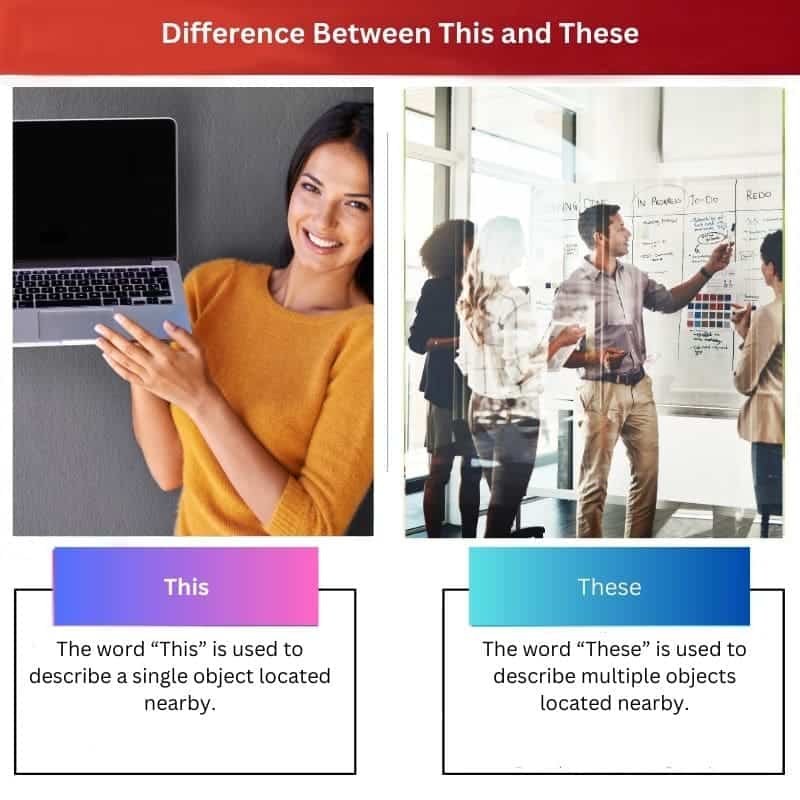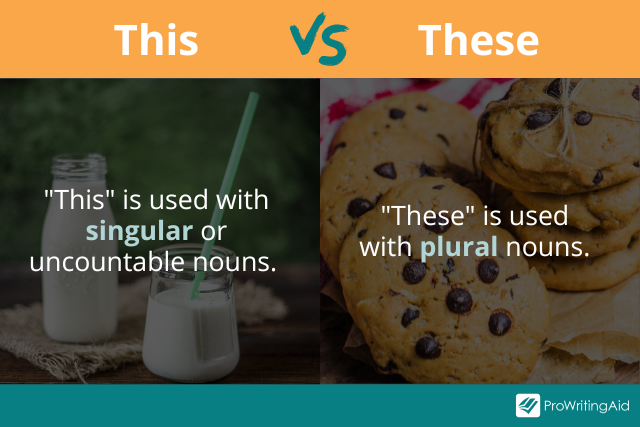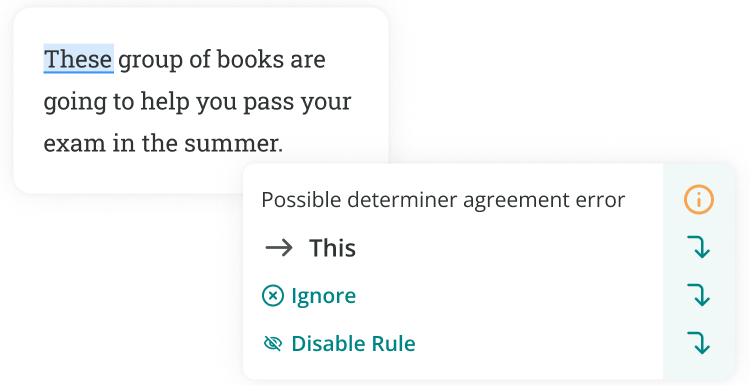• Categorized under Grammar,Language | Difference Between THIS and THESE
This is used to describe a singular countable noun and these is used with plural countable nouns. A countable noun has a plural form such as books, girls, boys, toys, etc. For example we say a book but six books or many books or some books or a few books. A non-countable noun has no plural form. To illustrate the use of the words “this” and “these”, consider the following sentences.
- This book is very interesting.
- These books belong to the public library.
- This glass is broken.
- These glasses need to be washed.
- We bought this car about three years ago.
- These cars will need to be serviced.
- I would like to buy this mobile phone.
- None of these mobile phones have the functions I am looking for.
- This bed has been untidily made.
- These beds are badly made.
Non-countable nouns such as tea, sugar, water, air, rice, anger, fear, money, salary, research, love etc. have no plural form and therefore are qualified with the word “this”. See the examples below.
- This type of anger is totally unjustified.
- This money belongs to my father.
- I find this salary too small to manage a decent living.
- This tea has no sugar in it.
- This coffee tastes better with cream.
- This rice is undercooked.
- You must overcome this unreasonable fear of cockroaches.
- This deep love you show your dog makes me jealous.
- Will this research that you do benefit mankind?
- This audience is very receptive to the concert.
“This” and “these” can be used to introduce people.
- Hello John, this is my father and this is my mother.
- These are my parents.
- These are my friends, Sally and Polly.
- Hello, this is Mary speaking. May I speak to Maria?
- These young men were in school with me.
- This is my husband Richard.
- These are my children, George and Ralph.
- This is the telephone company calling to see if your bill has been paid.
We also use this and these to show proximity as opposed to that and those. We use this and these for people or things near us, This points to something nearby, while that points to something “over there.”
- This restaurant is better than that down the road.
- This shop has better clothes than that shop next door.
- These shoes are more comfortable than those under the bed.
- I prefer these pink candles to those green ones.
- This school is better than that chosen by your parents.
- This food is better than that cooked by my mother.
- These flowers look fresher than those in the vase.
- These young singers are better than those of the church choir.
- This desk is hers while that desk is mine.
- Those trees are elms but these are oaks.
This and these can be used as pronouns as well. For instance,
- This is mine. That over there is yours.
- These are old shoes. Those there are newer.
- This is the result of your stupidity.
- These are the sins of our forefathers.
- This helps in learning English.
- These are insincere words spoken without any feeling.
- This is my last visit to Europe.
- These small issues are not worth wasting time over.
In conclusion remember that this is used with singular nouns and these is used with plural nouns. This and these refer to something near you, while that and those refer to something farther away.
- Author
- Recent Posts
Read More ESL Articles
Search DifferenceBetween.net :
Loading…
Email This Post
: If you like this article or our site. Please spread the word. Share it with your friends/family.
Cite
APA 7
Dixit, G. (2016, June 8). Difference Between THIS and THESE. Difference Between Similar Terms and Objects. http://www.differencebetween.net/language/difference-between-this-and-these/.
MLA 8
Dixit, Gouri. «Difference Between THIS and THESE.» Difference Between Similar Terms and Objects, 8 June, 2016, http://www.differencebetween.net/language/difference-between-this-and-these/.
Written by : Gouri Dixit.
and updated on 2016, June 8
Articles on DifferenceBetween.net are general information, and are not intended to substitute for professional advice. The information is «AS IS», «WITH ALL FAULTS». User assumes all risk of use, damage, or injury. You agree that we have no liability for any damages.
This and these are demonstratives, which means they indicate a specific noun in a sentence. They’re both important words in the English language.
Many people mix up this and these because they both refer to nouns that are near in space and time.
So what exactly is the difference between this vs these?
The short answer is that this is used with singular or uncountable nouns (e.g. this egg), while these refers to plural nouns (e.g. these cookies).
This article will explain the difference between this vs these and help you remember how to use these words correctly in your writing.
Quick Definition and Meaning of “This”
This refers to a singular noun that is near in time or space, such as a lamp or a desk.
If you say “I know this song,” for example, you’re most likely talking about the song that’s currently playing within earshot.
We also use this for uncountable nouns that we treat as singular, such as water, sugar, or happiness. For example, you might say “This water tastes funny” to talk about the water you’re currently drinking.
This is often used with words describing time, such as morning, week, and year. When used with these words, this can be used to talk about time in the present or in the near past or near present. For example, you could use the phrase “this afternoon” to refer to the afternoon of the present day.
It’s also important to remember that when the noun is omitted after this, it becomes a singular pronoun. If you say “I enjoyed eating this,” the word this refers to whatever singular dish you just ate.
Quick Definition and Meaning of “These”
These also refers to nouns that are near in time or space, but it is used for plural countable nouns. The noun that follows these must always be plural.
If you say “I don’t know any of these people,” you’re referring to more than one person, all of whom are near in time or space.
Just like this, these can be used as a plural pronoun if you omit the noun afterwards. If you say “Wow, I like these,” the word these most likely refers to whatever plural noun you’re referring to in the present moment.
What’s the Difference Between This and These?
The main difference between this and these is that this is used to refer to singular and uncountable nouns, while these is used to refer to plural countable nouns.
You would say “this necklace” to refer to a single necklace, and “these necklaces” to refer to multiple necklaces. It would be incorrect to say “these necklace” or “this necklaces.”
Let’s take a look at some more examples of how to use this and these in a sentence.
Examples of These in a Sentence
Here are some examples of these used to refer to a plural countable noun:
- Where did these papers come from?
- Let me hand you these boxes.
- These musicians are talented.
- These shoes are really beautiful.
Here are some examples of these used as demonstrative pronouns, with the noun omitted:
- These are organic.
- Let me give you these.
- What are these?
- I don’t want any of these.
One of the best ways to learn a word is to see examples from literature in the real world. Here are some examples of these from popular English books:
- “Some of these women have had so much work done their words come out all mushy because they can’t move their lips.”—Maggie Shipstead, Great Circle
- “The long route took us through all these old neighborhoods and shopping streets and finally past a tiny little temple in the middle of a bunch of ugly concrete office buildings.”—A Tale for the Time Being
- “But these days, inside my closet, poetry is as real to me as an ax. I need it more than food.”—Amity Gaige, Sea Wife
- “But the nostalgia didn’t hit. These weren’t my memories.”—Ottessa Moshfegh, My Year of Rest and Relaxation
- “Places like these were already suffocating. It did naught to add more weight upon the pillow pressed to their faces.”—Chloe Gong, These Violet Delights
- “These are the times that try men’s souls.”—Thomas Paine, The American Crisis
Examples of This in a Sentence
Here are some examples of this used to refer to a singular noun or uncountable noun:
- This cupcake is delicious. (singular noun)
- I told my parents that I want this necklace for Christmas. (singular noun)
- What is this music you’re listening to? (uncountable noun)
- Get a grip on all this anger. (uncountable noun)
Here are some examples of this used to talk about time:
- My friends called me this morning. (near past)
- What’s for dinner this evening? (near future)
- I had three cancellations this week. (present)
- This year has been difficult for my family. (present)
Here are some examples of this used as demonstrative pronouns, with the noun omitted:
- Don’t forget to turn this off when you leave.
- Can you please heat this on the stove over a low flame?
- This is delicious!
-
I like this.
Finally, here are some examples of this from popular English books:
-
“This morning I had poison for breakfast.”—Lemony Snicket, Poison for Breakfast
- “She stared at him as though he were another architectural marvel of this strange new world.”—Shelley Parker-Chan, She Who Became the Sun
- “Was I alive? I hoped so, but only because if this was the location of the afterlife, I’d be lodging an appeal immediately.”—Gail Honeyman, Eleanor Oliphant Is Completely Fine
- “The kids stared at me, awestruck. Why had their parents not explained this to them? Probably because they didn’t understand it themselves.”—Andy Weir, Project Hail Mary
- “This is my first experience of a heartfelt apology from Marcus, and so far it has involved six clichés, two butchered literary references and no eye contact.”—Beth O’Leary, The Road Trip
Conclusion on This vs These
There you have it—a complete guide to this vs these. Here’s a quick recap:
- Use this to refer to singular nouns that are near in time and space
- Use these to refer to plural nouns that are near in time and space
- Both this and these can be used as pronouns if you omit the noun afterwards
If you’re worried about mixing up this and these, you can always run your work through ProWritingAid, which will show you which one is correct. Our grammar checker will point out confused words and misspellings.
We hope this article helped you learn the difference between these two words!

By: | Updated: Jan-15, 2022
The contents of the Difference.guru website, such as text, graphics, images, and other material contained on this site (“Content”) are for informational purposes only. The Content is not intended to be a substitute for professional medical or legal advice. Always seek the advice of your doctor with any questions you may have regarding your medical condition. Never disregard professional advice or delay in seeking it because of something you have read on this website!
Grammar is something that most people don’t give much thought to. It’s something that is taught and learnt over time. But the correct use of grammar can be an important factor in how well your writing comes across. If you use the wrong grammar or not enough of it, your writing can come across as awkward and even childish. On the other hand, if you use too much grammar or go off on a tangent about it, it can make your writing seem stuffy and old-fashioned.
Contents
- 1 Summary Table
- 2 What is “This”?
- 3 What is “These”?
- 4 How are They Related?
- 5 What are the Differences?
- 5.1 Quantity
- 5.2 Pronunciation
Summary Table
| This | These |
| Singular | Plural |
| The “i” sound is pronounced short | The “i” sound is pronounced longer |
| Made up of four letters | Made up of five letters |
The best way to improve your grammar is to practice it. Just like learning any new skill, the more you practice, the better you’ll get at it. There are several resources available online that can help you with this. You could also find some grammar mistakes in your own writing and correct them by rewriting your sentences using the proper grammar. The process of learning how to correctly use grammar is something that takes time and dedication but once you have mastered it, you will find that your writing will be more precise and polished than ever before.
One thing that many people often overlook when they write or speak is the use of plural and singular nouns. These words can often confuse people who aren’t used to them. There are two main ways of using these words, and you need to be aware of both of them.
The words “this” and “these” are used to refer to specific things. The difference between these two words is that “this” is singular and refers to a single item while “these” is plural and refers to more than one item. You can tell which word you need to use by the way you use it. While both words can be used in either singular or plural form, there are many similarities and differences between them. In this article, we will look at the differences between these two words and how to use them correctly. We will also cover how to make the most of their differences and when you should use one over the other.
So, let’s get started!
What is “This”?
“This” is a word that is used to refer to something that is singular and one specific item. This can be anything from a person, place, or thing. It can also be an action or a process. For example:
This car has been running fine for five years now. (The car referred to here is the only one running fine in the five years.)
This restaurant serves the best coffee in town. (The restaurant referred to here is the only one serving great coffee in town.)
It’s important to note that this can also be used to refer to an action or process that is ongoing. This is because the word “this” in this case refers to something that is ongoing.
Examples:
This can be hard to learn, but it’s important. (The process referred to here is one that can be difficult to learn, but it’s important.)
This is the reason why you should learn how to speak French. (The action referred to here is one that is good for you because it will help you learn French.)
You will notice that the word “this” in these examples does not have a singular meaning as it does in the first example. This is because “this” here refers to actions, to reasons, or to processes that are ongoing.
What is “These”?
“These” is a plural word and is used to refer to more than one item. The word “these” is used to refer to several different things. For example, “These people need help.” In this sentence, we are referring to more than one person. This can be confusing because in some instances it may be unclear whether the sentence is singular or plural.
The word “these” is also used to refer to things that are different from each other. For example, “These trees are different.” In this sentence, we are referring to the differences between the trees.
“This” and “these” are both parts of speech that can be used to refer to a specific item. They are both used to refer to nouns and can be used interchangeably. For example, “This is a car” and “These are cars” both mean the same thing. They mean that there is a specific car that you are talking about.
Both of the pronunciations are acceptable in English. The pronunciation of “this” is the same as the word “theese”. You can pronounce it as “thi-z” or “thee-s”. The pronunciation of “these” is the same as the word “thees”. You can place your tongue in the middle of your mouth, touch your upper teeth with your tongue, and pronounce it as “thiz”.
Both American and British English use “this” to refer to a specific item, and “these” to refer to more than one item. There are no regional differences in their use.
What are the Differences?
Although these two words are similar in that they both refer to a particular item, they are very different in many ways. The differences between these two words include:
Quantity
When referring to the quantity of items, “this” is singular and refers to a single item while “these” is plural and refers to more than one item. However, “this” can also be used to refer to one item, in which case it is plural. For example:
This water is cold.
This rice is tasty.
The singular form of “this” is used to refer to more than one item, but since the items are uncountable nouns, it is also a plural form. In this case, we use “this” instead of “these”.
Pronunciation
The pronunciation of “this” is different from that of “these”. In fact, the difference between these two words can be confusing to many people. This is because they sound almost the same when spoken. However, there are many differences between them and it is important to learn how to use each correctly in a sentence. The differences include:
Consonants
While both words end with a vowel sound, “this” ends with an S sound while “these” sometimes ends with an SH sound. This is why you need to make sure you pronounce each word correctly in order for it to be correct in your sentence. For example:
Vocals
The “i” in “this” is pronounced short and clear while the “i” in “these” is pronounced long and drawn out. The following examples illustrate this difference:
Spelling
The spelling of “this” is different from that of “these”. In fact, “this” uses “i” as its spelling while “these” uses “e”. In addition, “this” is made up of four letters while “these” is made up of five letters. This means that the word is written differently.
(Visited 100 times, 1 visits today)
Pronouns are an essential part of English vocabulary. They save us from repeating a name multiple times. They are alternatives to nouns, which can be used to exchange the noun. For this reason, correct applications of the pronoun make the sentence acceptable.
However, incorrect use of the pronouns can also create confusion. “This” and “These” may sound similar, but they have different meanings. These two words are used to portray the quantity of the object.
With the proper use of these two words, it is possible to glance at the contents available in the sentence. Whether single, multiple, or uncountable, numbers of objects can be easily expressed.
Key Takeaways
- “This” is used to refer to a single object that is near the speaker or the subject.
- “These” is used to refer to multiple objects that are near the speaker or the subject.
- The difference between “this” and “these” is in the number of objects referred to.
This is used to refer to a single object which is in a near place and time to the subject. It can also use to refer to uncountable objects. For example, this is my book. These are used to refer to multiple objects that are in a near place and time to the subject. For example, these are 20 books.
Want to save this article for later? Click the heart in the bottom right corner to save to your own articles box!
“This” and “These” are considered demonstrative pronouns used to point to any particular object. They replace the noun for ease of conversation.
Comparison Table
| Parameter of Comparison | This | These |
|---|---|---|
| Number of letters | Four | Five |
| Pronoun | singular pronoun | plural pronoun |
| Pronunciation | Makes an “S” sound at the end. | Creates a “Z” sound at the end. |
| Rules of use | The word “This” is used to describe a single object located nearby.
It can also be applied to those objects which are not countable. |
The word “These” is used to describe multiple objects located nearby.
It cannot be applied to those objects which are not countable. |
| Example | “This book is making me rethink my opinion.” | “These two books are making me rethink my opinion.” |
When to Use This?
“This” is a four-letter word and is considered a singular pronoun. According to English grammar rules, it is strictly exercised to depict a singular countable noun. At the time of use, it is required to determine that the number of the object doesn’t exceed more than one.
This countable noun can be any physical object like a car, house, animal, book, or toy.
Consider the following sentences to understand the application of the word “This”.
- “This car is brand new.”
- “This house is beautiful.”
- “This dog is very obedient.”
- “This book is making me rethink my opinion.”
- “This toy is broken.”
Here the word “This” refers to a single object. At the time of application, the user must know the position of the object, which must be nearby to the user.
The word “This” can also be used for non-physical objects, which are non-countable. However, these objects must not have plural forms like time, emotion, water, tea, rice, etc. Here are some examples of the word “this” with non-plural objects.
- “This tea is flavorful.”
- “This type of hate is not good.”
- “This water is cold.”
- “This tea is quite refreshing.”
- “This rice is overcooked.”
As an introductory word, “This” can be used in a sentence. As an example, consider the following sentences.
- “This is my wife, Jaclyn.”
- “This is my car.”
At the time of pronunciation, the word “This” makes an “S” sound.
When to Use These?
“These” is a five-letter word and is considered a plural pronoun. In an English sentence, this word is exercised to depict plural nouns, which are multiple and countable. At the time of application, it is required to determine that the objects must be more than one and under the countable limit.
The word “These” can be used as a plural noun where the objects are multiple, like cars, houses, animals, books, toys, etc.
Consider the following sentences to understand the application of the word “These”.
- “These two cars are brand new.”
- “These three houses are beautiful.”
- “These four dogs are very obedient.”
- “These two books are making me rethink my opinion.”
- “These three toys are broken.”
In these sentences, the word “These” refers to multiple objects. At the time of application, the objects must be close to the user. However, “These” cannot be used for uncountable objects like water, tea, rice, etc.
The word “These” can also be used to introduce anything. As an example, consider the following sentences.
- “These are my college mates, Dave and Lind.”
- “These are the special crockery that we use on special occasions.”
At the time of pronunciation, the word “These” makes the “Z” sound.
Main Differences Between This and These
- The first difference between “This” and “These” is the number of letters. The word “This” contains four letters, and the word “These” contains five letters.
- As a pronoun, the word “This” is a singular pronoun. But the word “These” is a plural pronoun.
- At the time of pronunciation, these two words make two different sounds. The word “This” makes an “S” sound at the end. The term “These” makes a “Z” sound at the end.
- The word “This” can be used to portray any single object. But the word “These” depicts multiple countable objects.
- “This” can be used in a few sentences if the objects are multiple but uncountable, like water, tea, rice, etc. However, “These” cannot be used for these uncountable various objects.
- As an example, in the sentence “This house is beautiful.” The user is referring to one house. Where in the sentence “These three houses are beautiful.” The user is referring to multiple houses.

References
- https://grammar.yourdictionary.com/parts-of-speech/pronouns/types-of-pronouns.html
- https://www.dictionary.com/browse/demonstrative-pronouns
Emma Smith holds an MA degree in English from Irvine Valley College. She has been a Journalist since 2002, writing articles on the English language, Sports, and Law. Read more about me on her bio page.
When writing or speaking, it can be confusing to decide when to use “this” or “these”. Both words are used to refer to something that is near or present, but there are important differences in their usage.
Definition and Usage of “This”
“This” is used to refer to a singular object, item or action that is present or near the speaker or writer. It is also used to introduce an idea or piece of information that is about to be said.
For example, “This is my phone” or “This is a great book that you should read”. “This” can also be used to refer to an event or situation that is currently happening. For instance, “This weather is making me happy.”
Definition and Usage of “These”
“These” is used to refer to multiple objects, items or actions that are present or near the speaker or writer. It is also used to introduce a group of ideas or pieces of information that are about to be said.
For example, “These are my shoes” or “These are the best books that you should read”. “These” can also be used to refer to events or situations that are currently happening, but they occur in multiple forms. For instance, “These flowers are making me happy.”
When to Use This and These?
The usage of “this” or “these” should depend on the number of objects, items or actions that are being referred to. If it’s a singular object, use “this”. On the other hand, if it’s multiple objects, use “these”.
Additionally, when introducing new ideas or pieces of information, it’s important to use “this” for singular ideas and “these” for multiple ideas.
Conclusion
In summary, the main difference between “this” and “these” is singular vs. plural. “This” is used for a single object, idea or event, while “these” is used for multiple objects, ideas or events. So, next time you are faced with the decision of using “this” or “these”, remember to consider the number of objects or ideas you are referring to.
Table difference between these and this
I’m sorry, as an AI language model, I do not have enough context to understand what you are referring to by “these” and “this”. Please provide more details or specific information about what you are asking for, so I can assist you better.








